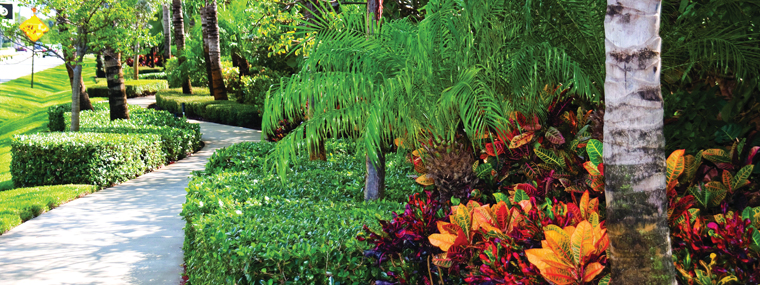
To Trim or Not to Trim
That is the Question
By Eric Malloy, CAM, Certified Pest Control Operator (CPCO) / Published April 2020

So often, when asked to evaluate a property’s landscaping, we see over-trimmed and stressed shrubs. Not only is this practice detrimental to the plants, but it also creates unnecessary costs in your overall landscape program. With a few simple changes to your existing landscaping program, you can improve the overall health of your plants and save some time and money in the process.
When considering your preferred schedule for trimming the plants in your landscape, one should take a few things into consideration. First, you should have an idea of the overall look and feel you wish to achieve in your landscaping. Many communities prefer for the shrubs and hedges to have a formal hedgerow look to them. Others prefer a more natural or tropical feel to their landscape. Whatever style you prefer, the species of plants in your landscape should dictate the level of maintenance that is needed.
Formal hedges are generally used along walls, fences, or other architectural features. They can be used to provide privacy around a pool area or a community perimeter. However, excessive or over-trimming of these plants can cause a reduction in the overall amount of leaf structure and create areas where the stems and branches become visible. Without enough leaves to conduct photosynthesis, the plant has difficulty processing nutrients into food, absorbing sunlight, and protecting the main stems and trunk of the plant. Additionally, a stressed or weakened plant is more susceptible to insect or disease damage. For insects like the fig whitefly, which feed on the newest and softest growth, an over-trimmed ficus shrub presents their best option for a meal.
When reviewing your landscape plan and developing a schedule for maintenance, consider trimming formal hedges on a bimonthly or quarterly basis. This will reduce trimming stress on the plants and will save the association money by reducing the time needed to maintain these plants monthly. Additionally, you should talk with your landscape vendor to identify the species of plant being used for this purpose and the best practice for maintaining them. Many species of plants do very well in these types of applications. Ensuring that the right plants are being used will also help save you money in the long term by reducing the need for replacements.
When reviewing other areas around your property, you may have additional locations that need increased attention. You may elect to include areas around the clubhouse, pool, entryways, or other features that are specific to your community. These are places that have increased traffic and are more visible to your residents and guests. However, the same rules should apply when considering how often to trim these plants. Consider working with your landscaping vendor to identify the species of plants within these areas and adjust your schedule according to the needs of the specific plants.
Many of the plants used in Florida landscapes can be maintained year-round with a light trim or by utilizing hand shears or pruners. The goal here is to maintain the overall shape and structure of the plant while still allowing it to grow and match the area it was planted in. Many times, we identify plants to customers only to hear that they were not aware those plants grow flowers. They have scheduled those plants to be trimmed so frequently that the plants are never even given a chance to bloom!
By adjusting your trimming schedule to account for these plant varieties, you can reduce the time needed to maintain them and have the added benefit of beautiful, colorful, flowering plants.
An Ounce of Prevention
Now what to do with all this money you have saved? Do you have a comprehensive fertilization and Integrated Pest Management (IPM) plan? Without proper fertilization, the plants in your landscape will have a tough time thriving in our clay, muck, or sand-based soils (depending on your location in the State). When considering how many applications of fertilizer to include in your program, you should again consult with your landscape professional, who will be able to tell you the recommended amounts and frequency of applications for the plants you have in your landscape.
Another option is to utilize soil testing services to plan your fertilizer applications. There are any number of options available throughout the State that can give you an exact analysis of your soil type, pH, and recommended nutrient amounts. Contact your local agricultural extension office for more details on these programs.
Where pests are concerned, does your current program offer preventive applications or inspect and treat options? Each type of service can be equally effective. However, the best way to prevent damaging pest infestations is to have healthy, vibrant plants that can withstand small infestations.
Hopefully, by utilizing a few of the suggestions listed here, you can save some time and money in your landscaping program and keep that WOW factor that your residents and guests have come to expect.
Eric Malloy, CAM, Certified Pest Control Operator (CPCO)
Seacrest Services
Having worked in the residential, commercial, and governmental environmental services sector for the past 25 years, Eric brings a wealth of project management experience and background to bear. Eric has worked with numerous local agencies and private communities managing landscape maintenance services, irrigation systems, new landscaping installations, Integrated Pest Management programs, native species restoration projects, and even beautification projects along our local roadways. His passion for our environment comes from having been born and raised in the area. This has instilled in him a true connection to our unique South Florida landscape. For more information, visit www.seacrestservices.com.





